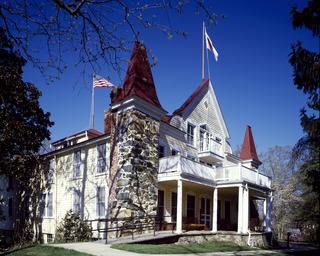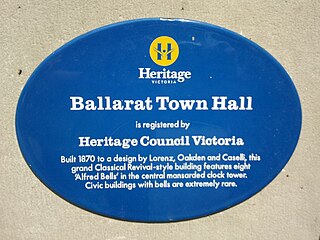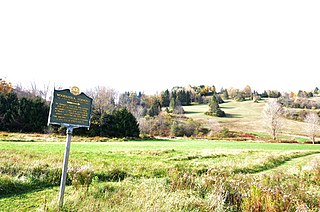
In the United Kingdom, a scheduled monument is a nationally important archaeological site or historic building, given protection against unauthorised change.

In the United Kingdom a listed building is a structure of particular architectural and/or historic interest deserving of special protection. Such buildings are placed on one of the four statutory lists maintained by Historic England in England, Historic Environment Scotland in Scotland, Cadw in Wales, and the Northern Ireland Environment Agency in Northern Ireland. The term has also been used in the Republic of Ireland, where buildings are protected under the Planning and Development Act 2000, although the statutory term in Ireland is "protected structure".

Mount Adams is a 3,520-foot-tall (1,070 m) mountain located in Essex County of New York. Atop the mountain is the Mount Adams Fire Observation Station, added to the National Register of Historic Places in 2006.

The Darwin D. Martin House Complex is a historic house museum in Buffalo, New York. The property's buildings were designed by renowned architect Frank Lloyd Wright and built between 1903 and 1905. The house is considered to be one of the most important projects from Wright's Prairie School era.

The Clara Barton National Historic Site, which includes the Clara Barton House, was established in 1974 to interpret the life of Clara Barton (1821–1912), an American pioneer teacher, nurse, and humanitarian who was the founder of the American Red Cross. The site is located 2 miles (3.2 km) northwest of Washington D.C. in Glen Echo, Maryland.

The George F. Barton House was designed by Frank Lloyd Wright, built 1903–1904, and is located at 118 Summit Avenue in Buffalo, New York. The Barton House is part of the larger Darwin D. Martin House Complex, considered to be one of the most important projects from Wright's Prairie School era.

The John Muir National Historic Site is located in the San Francisco Bay Area, in Martinez, Contra Costa County, California. It preserves the 14-room Italianate Victorian mansion where the naturalist and writer John Muir lived, as well as a nearby 325-acre tract of native oak woodlands and grasslands historically owned by the Muir family. The main site is on the edge of town, in the shadow of State Route 4, also known as the "John Muir Parkway."

A historic site or heritage site is an official location where pieces of political, military, cultural, or social history have been preserved due to their cultural heritage value. Historic sites are usually protected by law, and many have been recognized with official historic status. A historic site may be any building, landscape, site or structure that is of local, regional, national, or global significance. Usually this also means the site must be at least 50 years or older.

Heritage Victoria is a branch of the Victorian Department of Transport and Planning. It is the regulator responsible for administering the Heritage Act 2017. The Heritage Act provides for the protection and conservation of the cultural heritage of Victoria and establishes the Victorian Heritage Register and Heritage Inventory. The Register is a list of places and objects which are of significance to the State of Victoria. The Inventory is a list of known historical archaeological sites. Both statutory lists can be searched via the Victorian Heritage Database.
The history of the National Register of Historic Places began in 1966 when the United States government passed the National Historic Preservation Act (NHPA), which created the National Register of Historic Places (NRHP). Upon its inception, the U.S. National Park Service (NPS) became the lead agency for the Register. The Register has continued to grow through two reorganizations, one in the 1970s and one in 1980s and in 1978 the NRHP was completely transferred away from the National Park Service, it was again transmitted to the NPS in 1981.

Crystal Lake State Park is a day-use state park and historic site in Barton, Vermont, United States. It is located at 96 Bellwater Avenue, off Willoughby Lake Road just east of the village, at the northwestern end of 763-acre (309 ha) Crystal Lake. It features a sandy beach with swimming area, and a bath house built by the Civilian Conservation Corps (CCC). A cottage is available for rental. The park was added to the U.S. National Register of Historic Places on August 30, 2005, for its association with the CCC.

Barton Academy is a historic Greek Revival school building located on Government Street in Mobile, Alabama, United States. It was under construction from 1836 to 1839 and was designed by architects James H. Dakin, Charles B. Dakin, and James Gallier, Sr. Gallier and the Dakin brothers also designed the nearby Government Street Presbyterian Church. Barton Academy was the first public school in the state of Alabama.

The Guy C. Barton House was a very elaborate and expensive Victorian home in the Midtown area of Omaha, Nebraska, United States, a home and entertaining center of an industrialist and philanthropist. The house caught fire and was demolished in 1982.

The Frenchglen Hotel State Heritage Site is a hotel in the sparsely populated southeast part of Oregon, United States. It is located in the small village of Frenchglen, near the base of Steens Mountain and at the northern end of the loop road that ascends almost to the mountain's summit above 9,000 feet (2,700 m).
Historic England is an executive non-departmental public body of the British Government sponsored by the Department for Culture, Media and Sport. It is tasked with protecting the historic environment of England by preserving and listing historic buildings, scheduling ancient monuments, registering historic parks and gardens and by advising central and local government.

The historic Humboldt Post Office building is located at the corner of Main Street and 6th Avenue in Humboldt, Saskatchewan, Canada. The building is 2+1⁄2 storeys with a 4-storey bell and clock tower. Designed by the chief architect of the Department of Public Works, David Ewart, the building is the last surviving of a series of very similar buildings under a common theme on the prairies. The building originally housed a post office, customs, and weights and measures office on the ground floor; customs and inland revenue offices and an office for the commanding officer of the Royal Canadian Mounted Police (RCMP) on the second floor, while the third floor housed caretaker's quarters and RCMP offices quarters.

Barton Heights is a streetcar suburb neighborhood and former town in the Northside area of Richmond, Virginia. The area was primarily developed between 1890 and the 1920s.
The National Heritage List for England (NHLE) is England's official database of protected heritage assets. It includes details of all English listed buildings, scheduled monuments, register of historic parks and gardens, protected shipwrecks, and registered battlefields. It is maintained by Historic England, a government body, and brings together these different designations as a single resource even though they vary in the type of legal protection afforded to them. Although not designated by Historic England, World Heritage Sites also appear on the NHLE; conservation areas do not appear since they are designated by the relevant local planning authority.
A heritage asset is an item that has value because of its contribution to a nation's society, knowledge and/or culture. They are usually physical assets, but some countries also use the term in relation to intangible social and spiritual inheritance. The term is found in several contexts:

Gilbert's Hill, also known more recently as the Appel Farm, is a historic farm property and former ski area at 1362 Barnard Road in Woodstock, Vermont. Developed as a farm in the mid 19th century, it was developed as a downhill ski area in the early 20th century, and is the location of the first rope tow in the northeastern United States. It was listed on the National Register of Historic Places in 2019. The property is privately owned, but is open to the public via conservation and historic preservation easements.

















